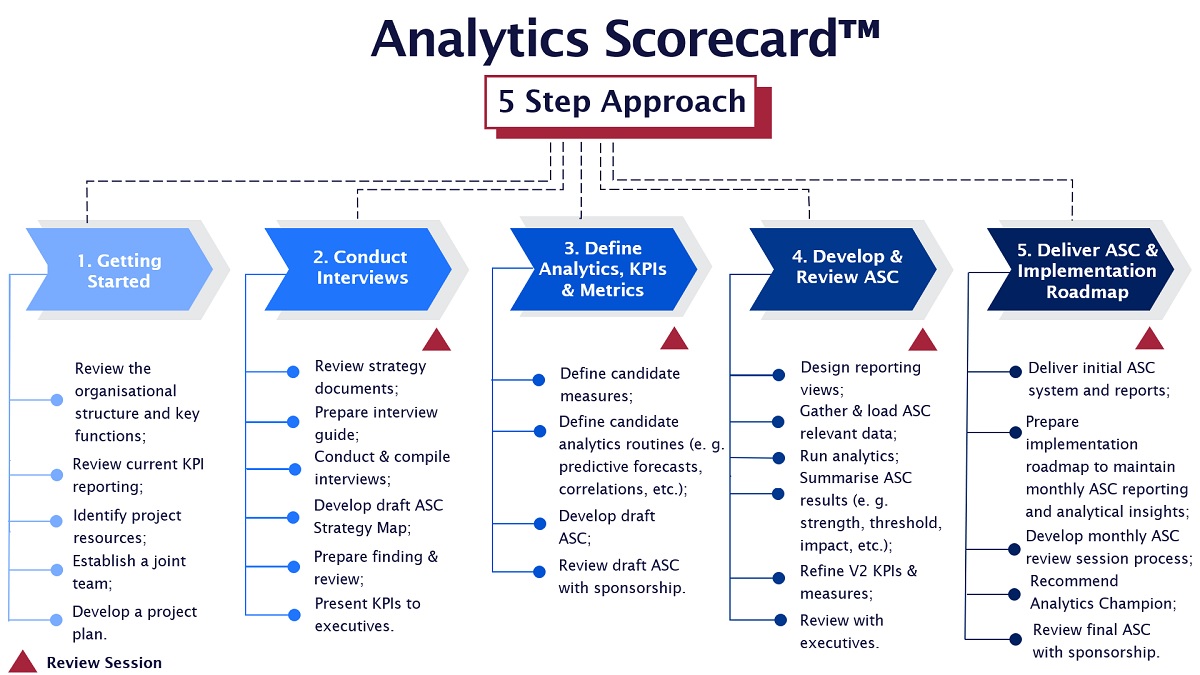FP&A helps create sources of future value whilst being on top of how much value is...

The Analytics Scorecard™ (ASC)1 is a tool to analytically establish and measure Key Performance Indicators (KPIs) that impact corporate goals and the associated strategic objectives. It is designed to help managers and decision-makers understand how their business is performing against their strategic objectives, identify areas for improvement, enable efficient collaboration, and facilitate data-driven decisions to increase growth and profitability.
In this article, we discuss how using Strategy Maps with AI-enabled analytics becomes an excellent technique for visually elucidating strategic objectives with the corresponding KPIs, forming financial and operational metrics, and highlighting their interdependences with the help of an Analytics Scorecard™.
Benefits the Analytic Scorecard™ Brings to Business
One of the key benefits of the Analytics Scorecard is to transform the biased understandings of the relation between strategy and KPIs that are assumed to be true to unbiased analytics-proven relations that contribute to reaching the goals. The ASC thus provides ongoing reporting to all team members to reveal measurable progress in achieving the strategic objectives. It assures organisational teams are on the same page and avoids confusion or misinterpretation of data.
The ASC also provides a holistic view of the organisation’s performance. By tracking various metrics, managers can gain insights into how different aspects of the business are performing and prioritise areas for improvement and investment, along with areas to defer or abandon. Applying AI and advanced analytics reveals unseen risks and unknown opportunities for more effective decision-making.
How To Create the Analytics Scorecard™
The ASC is easily understood and interpreted by all team members. The ASC is tailored to the organisation to identify goals, strategic objectives to achieve the goals, KPIs to achieve the strategic objectives, and the associated measures for each KPI. The KPIs and measures can be financial and non-financial in nature. For example, a KPI may be focused on website analytics, whilst the metrics could include website traffic, page views, bounce rate, and conversion rate.
The first step in creating the Analytics Scorecard™ is identifying what the organisation “thinks” are the goals, critical strategic objectives, and KPIs. The KPIs are then associated with defined measures that analytics are applied against to quantitatively establish if the KPIs do indeed affect the strategic objective and if the latter supports the goals.
Metrics are thus unbiasedly validated as to their driver impacts on operations to confirm the cause-and-effect relationship and gauge the strength and threshold of that relationship.
Often, these strategic objectives and their associated metrics are qualitative and assumptive. By applying data analytics, we confirm (or invalidate) and quantify goals, e.g., correlations between customer satisfaction and customer churn, which might reveal (or confirm) a relationship. Analytics can further show the customer satisfaction rating or “breakpoint” that defines whether a customer will or will not churn. Being able to link KPIs and their corresponding objectives enables executives to make decisions based on the analytics on data instead of feelings or biases about the business drivers2.
The Analytics Scorecard™ is updated regularly to reflect organisational performance and ensure that KPIs remain relevant. It should also be used as a tool for continuous improvement, as managers can take corrective actions. Once KPIs and data sources are identified, the Analytics Scorecard™ can be implemented using commercially available analytics tools.
Implementing ASC for the Right KPIs to Increase Performance
In several real-world projects, we have demonstrated that executives can better understand where to focus by applying analytics to find the connection between business drivers and the underlying value driver.
The company is a global manufacturer and service provider of cybersecurity systems and software. It contracts its manufacturing and delivery through 3rd party distributors and Value-Added Resellers (VARs). The company recently organised a Center of Excellence within its Global Operations Division and thought to improve its Key Performance Indicator (KPI) reporting to increase performance. The company engaged Aurora Predictions to implement analytics-driven KPI reporting based on the Analytics Scorecard™ developed by Messrs. Maisel, Zwerling, and Sorensen in the book "AI-Enabled Analytics For Business", published by Wiley.
A review of the current state of KPI reporting resulted in the following assessment:
- What is currently called KPI Reporting is a collection of functional groups with stovepipe reports of analysis with some metrics.
- Reporting can’t be traced or linked to corporate strategy.
- The reporting value’s impact on strategy is unclear.
- Reporting has limited comparative analysis to budget.
- Reporting has historical values with few forecasts.
- Reporting is without unbiased analytics confirmation and its impact on future performance.
Specific Challenge
The company was accustomed to its reporting and reluctant to adopt a new approach. As with any change, there is a modicum of resistance. The project’s original scope was across operations, where receptivity varied by a group leader, ranging from hesitation to resistance.
Before commencement, the customer was instructed to "pre-sell" the project to its managers and staff. However, this wasn’t done, and the kickoff meeting was held with bewilderment about the project’s purpose. This caused a month-long Change Management education and a decrease in the number of participants. Only those that displayed the most interest were chosen to participate.
However, the Analytics Scorecard™ (ASC) has exceptional value because it enables better decision-making for management processes with higher confidence levels. Simultaneously, it also affords higher planning accuracy that materially reduces variance to plan by:
- Identifying, analytically confirming, and focusing on KPIs and measures that increase performance.
- Gaining unbiased AI-enabled analytics insights for more accurate and longer-range planning.
- Providing correlations to reveal the internal and external business drivers.
- Coordinating operational activities to ensure alignment with and the impact on strategy.
At the outset of the project, the goals of the ASC were established as below.
- Ensure KPIs and metrics align with strategic objectives.
- Establish SMART KPIs: i.e., Specific, Measurable, Achievable, Relevant, and Time-bound.
- Use analytics assessment for each strategic objective to validate that the associated KPI does support its strategic objective.
- Develop the ASC Strategy Map to enable teams to see the interrelations of their activities with each other and integrate with strategic goals to know where they are, where they need to go, why something happened, and whether corrective strategies are impactful.
- Engage leadership to define success for each KPI and communicate that to employees for coherent behaviour.
The Analytic Scorecard™ Project: Approach and Stages
Analytics projects should start small, gain wins, build momentum, and then scale. The figure below presents the high-level 5 steps of the ASC project. An understanding of the organisation is collected in "Getting Started". "Conduct Interviews" establishes each team member's understanding of their role and strategy, from which the first Strategy Map with its KPIs is constructed during the "Define Analytics, KPIs & Metrics" stage.

Figure 1
Next, the ASC table is built during the "Develop & Review ASC" stage. It integrates the strategic objectives with their KPIs and, for each KPI, the associated measure, validation test, strength & direction, threshold, and impact.
A KPI has a measure (a quantitative value), and there is a validation test to confirm or refute the KPI's ability to affect its strategic objective, along with the strength & direction of the KPI to affect the latter. Analytics also tests for the threshold needed for the KPI to affect the Strategic Direction and to identify which threshold does not affect the strategic objective. Finally, analytics calculates the impact by which the KPI will affect its strategic objective once the threshold is attained.
The completed ASC and the corresponding KPI reporting are delivered in Step 5: "Deliver ASC & Implementation Roadmap".
Outcome
The Strategy Map enlightened the team on the relationship between their roles and connected their work to the overall corporate strategy. Five corporate Strategic Principles were each assimilated with a Strategic Theme, and with each Theme, there was a related number of strategic objectives, with each objective having its KPIs.
Each group then provided data loaded into the Aurora LightZ AI-enabled analytics platform from which LightZ AI created analytics models. To complete the ASC table, each measure for each KPI was analysed for the associated strength & direction, threshold, and impact of the measure on the KPI. A sample of findings is listed below for one Strategic Theme of Customer Centricity. These were educational, clarifying, validating, and illuminating themes. Further, it should be noted that the use of LightZ enabled the development of a half dozen analytics models in days vs months for traditional analytics tools. Here are presented key outcomes from implementing the Analytics Scorecard™.
1. Customer Growth Dynamics – Correlations
These correlations revealed activities in sales orders and pricing weakening the relation between how many units of product are sold and the associated price to the volume of closed deals.
2. Customer Growth Dynamics – AI Predictive Signal (PS) & AI Probabilistic Forecast (PF)
The PS for revenue indicated a weakness in achieving the 2X revenue growth Strategic Object. However, the combined PS and PF give a powerful unbiased look into the future, including a deep dive into data for advanced action that can alter the current business trajectory.
3. Effective Problem Resolution – Correlations
The total Return Merchandise Authorisations (RMAs) aren't correlated with the number of deal closings means there's good control from good quality products and processes. However, RMAs one level deeper show a surprisingly weak correlation with the external indicators of Consumer Sentiment and Consumer Price Index.
4. Effective Problem Resolution
Here, detailed analytics identified some products with persistent and systemic issues, even though the products fall within the bands of reliability tolerance.
5. Order Processing – Operations Statistics
This powerfully shows the history of operations and predicts when it's about to change. Overall, it has operated largely within its norm, and there was no signal for implementing change.
6. Touchless Orders – Predictive Signal (PS)
It helps us reveal the key distributors and order pushback (i.e. error) codes that drive pushbacks. Insight is how Electronic Data Interchange (EDI) and manual orders contribute almost equally to order pushbacks. However, the PS for EDI is decreasing whilst manual is flat. As such, EDI is predicted to improve even as order volume increases but not necessarily so for manual.
LightZ produced the KPI reporting inclusive of probabilistic forecasts, predictive signals, and correlations that monitor operations towards attaining the strategic objectives. For the first time, Global Operations could visualise its connection with Strategic Principles and understand the contribution of each group's actions in Global Operations to achieve those principles.
Finally, the ASC is a beautiful innovation from the modern world of AI and analytics, enabling managers to explore the future, see the impact of today's operations on tomorrow's results and gain unbiased predictive analytical insights and perspectives.
--------
1 The concept of an Analytics Scorecard™ is conceived and described in "AI-Enabled Analytics for Business" by Maisel, Zwerling, and Sorensen, published by John Wiley & Sons, 2022
2 AI-Enabled Analytics for Business – A Roadmap for Becoming an Analytics Powerhouse © Copyright 2022 Lawrence S Maisel, Robert J Zwerling & Jesper H Sorensen. All rights reserved.
Subscribe to
FP&A Trends Digest

We will regularly update you on the latest trends and developments in FP&A. Take the opportunity to have articles written by finance thought leaders delivered directly to your inbox; watch compelling webinars; connect with like-minded professionals; and become a part of our global community.






